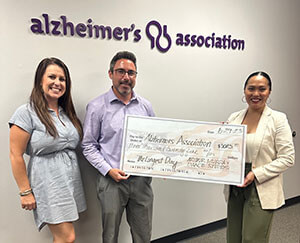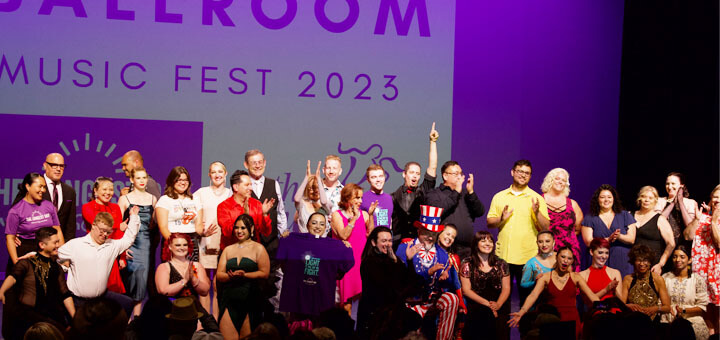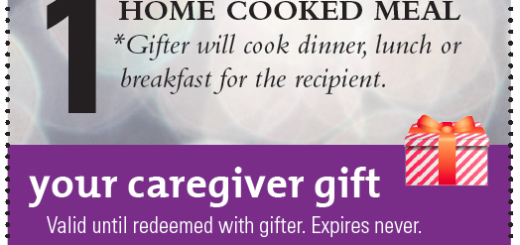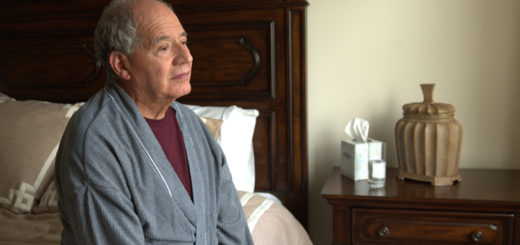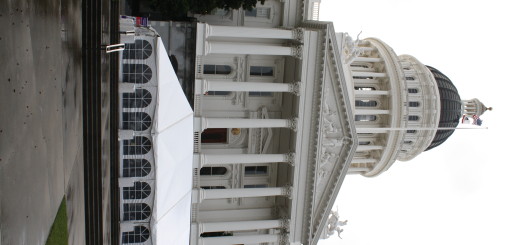Folsom-based ballroom dancers raise funds for Alzheimer’s Association
This past June, dancers from the Arthur Murray dance studio in Folsom came together to honor loved ones through dance. Performed at a local theater dancers performed as solo acts, duets or in groups to raise funds for The Longest Day®. Kate Gonzalez, studio director, shares her inspiration behind the event and why supporting the Alzheimer’s Association® is so important.
Supporting The Longest Day
The Arthur Murray dance studio in Folsom, has been supporting the Alzheimer’s Association for several years, using their shows as the primary way to raise funds. However, in 2020, during the pandemic, the studio put the safety of their dancers first and stopped performing.
This year, studio director, Kate Gonzalez decided she wanted to bring back one of their summer performances by doing something special and have it in a theater. When she tried to book the venue, the date she was able to get was June 21, which happens to be the day the Alzheimer’s Association celebrates The Longest Day.
“I wanted the show to be on a Friday night,” said Kate. “It’s so hard to book the theater. The only time was June 21 and it almost felt like kismet. It reminded me it’s The Longest Day. I’ve always wanted to come back. It’s the perfect opportunity to get back in this relationship [with the Association] and what our studio stands for. It’s something we can make an impact on.”
The Longest Day
The Longest Day is the day with the most light — the summer solstice. On June 21, thousands of participants from across the world come together to fight the darkness of Alzheimer’s through an activity of their choice. Together, they use their creativity and passion to raise funds and awareness for the care, support and research efforts of the Alzheimer’s Association.
Arthur Murray currently has 18 teams across the country who participated in The Longest Day this year, raising nearly $24,000.
The importance of dance
The Alzheimer’s Association’s 10 Ways to Love Your Brain shares that engaging in regular cardiovascular exercise that elevates your heart rate and increases blood flow to the brain and body reduces the risk of cognitive decline. Additionally, staying socially engaged may also support brain health. Both of these things that can be accomplished through ballroom dancing.
Research funded by the Centers for Disease Control and Prevention (CDC) at the University of Illinois in Chicago showed that a Latin ballroom dance program for older adults reported improvements in memory, attention, and focus. In another dance program, participants with mild cognitive impairment (MCI) saw improvement in their memory and thinking after a 10-month long ballroom dancing class.
Summer extravaganza
Kate marketed her ballroom dance show primarily as a way to support the Alzheimer’s Association. She and her dancers contacted television stations, posted their event on community boards and visited care facilities to promote the benefit show.
Tickets were sold on Eventbrite, with 50% of the proceeds going towards The Longest Day. During the show, raffles were held and at the end of the performance they had raised nearly $3,000. After the show, an usher came up to Kate and gave her $100 from a couple who had come to see the show and wanted to put them over the $3,000 mark. The husband had taken his wife, who was living with the disease, on a date. When the man gave the money to the usher his wife said, “I hope they find a cure for me before it’s too late.”
That night, 178 people came to see the show and $3,025 was raised.
The dancers
Any students interested in performing in the summer extravaganza were welcome to do so. There was a small fee to help cover the cost of the theater, but students could do any kind of dance they were interested in. On the day of the performance there were 40 dancers who participated. “There were solos, and couples who wanted to have the experience of dancing on stage,” said Kate. “This was a bucket list item for some people.”
Additionally, some performers had a connection to the disease and danced in honor of their aunts, husbands, family and friends. “We gave dancers the option to write their own introduction,” said Kate. “One woman, I knew her husband was unwell, but I didn’t know it was Alzheimer’s. She wanted to sign up because she thought it was so touching.
“[She was caring for her husband and] someone advised her to do something to fill her cup. She said she liked music and dance so maybe she’ll start dancing. She said, ‘I need this, I need to dance, I am so drained and I really want to do something for me to keep me going.’ She never talked about her husband until the show. Her dedication was to her husband and she danced to all their favorite songs. All of her friends and family came to watch her.”
Finding her calling
Kate and her husband opened the Folsom Arthur Murray dance studio because they wanted to make a difference and they have instilled this in the culture of their studio. “It’s important to us to have what we’re passionate about do good in society,” said Kate. “For those who come here, Ballroom dancing has already made an impact in their life. It feels good to make a difference. It feels good to impact people in some way or another.
“We’ve supported a bunch of local causes, but nothing comes as close to a connection as Alzheimer’s. Research on ballroom dancing specifically has a strong effect on people with dementia. Different points of contact through physical, emotional, mental and the social aspect it brings to the table. That’s a benefit [not only] to people who have [the disease, but also] those who are caregivers. When [partnering with the Association was] pitched that to us, [it was like] why haven’t we been on board sooner!”
“I’m a very spiritual person I feel that if you’re in a place it’s because you’re needed. If I can [make an] impact with the Association or people with Alzheimer’s, then I’m going to do it. Now that we’re talking about it, it’s in motion you see it everywhere, but it’s not talked about often. I want to be able to be some kind of podium for some people to talk about it or know about it.
“My husband’s father had dementia. It meant a lot to [my husband] to be able to do something like this. I pray to God that my husband and our children will always be in the best state of mind. If [Alzheimer’s] isn’t being talked about or supported, then I need to step up to the plate. Someone has to. When your convicted of something strong enough that conviction becomes a calling.”
Spreading the word
Kate loved seeing the dance community come together to be a part of the cause. “People only gather when it’s significant. If there is some kind of magic in it,” said Kate. “I’d walk into the studio and everyone was practicing their routine to do a good job on the show so it would be successful so we can do it again. It’s very powerful and very exciting.”
Additionally, Kate found it rewarding that she was able to reach a wider audience than she expected. She was pleasantly surprised to find that people from the community with no connection to the studio found their way to the performance.
After the performance many dancers came to Kate to tell her they can’t wait to do this again next year. They would like to help hand out flyers and spread the word about the event and the cause it supports. The theme for next year will be Broadway.
“I know people have walked out those doors and I may never talk to them again,” said Kate “They were there, and they experienced it and the love and care and the fight that everyone had talked about. I think that is beautiful.”
It’s not too late to raise funds for The Longest Day. Donate to Kate’s team, Arthur Murray Folsom & Rocklin or start your own at alz.org/thelongestday. If you’d like to make a donation to the 2023 season, donate by August 31, 2023. Otherwise come back in September to register for next year!





